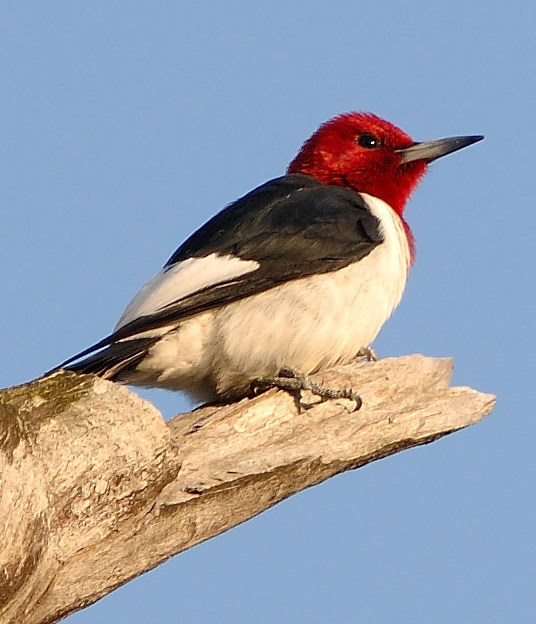Last updated: June 21, 2024
Article
Bird Community Monitoring at Arkansas Post National Memorial, 2019

NPS
Why Do We Monitor Birds?
Birds are an important part of the world we live in. They eat pests, disperse seeds, pollinate plants, and feed us, and birdwatching is a multi-billion-dollar industry. Park interpretive programs often feature birds because of the enjoyment they provide. Birds are also great indicators of environmental change. They serve as the canary in the coal mine, so to speak, for an ecosystem. Flood control and deforestation for agriculture threaten bird habitat in the region around Arkansas Post National Memorial. Unfortunately, 42% of the birds that breed at the park are in decline in the region. Some birds, like the Common Grackle, Common Yellowthroat, and Northern Bobwhite, are declining at alarming rates.
Scientists in the Heartland Inventory and Monitoring Network measure changes in birds and their habitat to determine the health of bird communities and park ecosystems. During the breeding season, we survey birds at Arkansas Post National Memorial and gather information about the structure and composition of the park plant communities that birds live in. We also compare bird trends in the park to trends in the larger region. Together, these data help researchers determine how bird populations are faring and how birds respond to changes in their environment. Knowing how birds are doing can help the park take effective steps to restore and maintain the park's beautiful landscapes.

NPS
Bird Communities at Arkansas Post National Memorial (2007–2019)
We have found 105 different bird species in 11 years of surveys (no surveys took place in 2008 and 2009). Ninety-three of these species have the potential to breed within the park. This is about 91% of the total species we would reasonably expect to be breeding here. We found an average of 43 bird species each year. Eight breeding species on the park are considered species of conservation concern for the Mississippi Alluvial Valley Bird Conservation Region, the region in which the park is located.
| Common Name | Scientific Name | AOU Code | Park Resident? |
|---|---|---|---|
| Bald Eagle | Haliaeetus leucocephalus | BAEA | year-round resident |
| Dickcissel | Spiza americana | DICK | summer resident |
| Kentucky Warbler | Geothlypis formosa | KEWA | summer resident |
| Least Bittern | Ixobrychus exilis | LEBI | summer resident |
| Orchard Oriole | Icterus spurius | OROR | summer resident |
| Prothonotary Warbler | Protonotaria citrea | PROW | summer resident |
| Red-headed Woodpecker | Melanerpes erythrocephalus | RHWO | year-round resident |
| Wood Thrush | Hylocichla mustelina | WOTH | summer resident |
Bird Habitat
Arkansas Post National Memorial is located in the forested floodplains of the Mississippi Delta in Arkansas. Historically, the Mississippi Alluvial Valley Bird Conservation Region contained the greatest bottomland hardwood forest on earth and was subject to massive annual flood events. This area has been greatly altered since European settlement. Less than 25% of the forest is remaining and flooding has been reduced by about 90%. Based on our surveys, the number of bird species increased from 2007 to 2019, suggesting that the habitat at Arkansas Post National Memorial has improved across the years and supports a rich array of birds. We will continue to monitor birds and how they respond to changes in their environment to help the park manage habitat for birds. Conserving bird habitat preserves entire ecosystems for the benefit of all species.

NPS

NPS
Trends of Common Bird Species
Eighteen bird species had populations that were common enough for us to measure abundance (how many individuals there were). Abundance measures allow us to look at bird population trends in the park and compare them with trends in the Mississippi Alluvial Valley Bird Conservation Region. Overall, the bird community in the park is faring as well as or slightly better than bird communities in the larger region.
- Thirteen species had populations that significantly increased in the park since 2007: Acadian Flycatcher, Blue-gray Gnatcatcher, Blue Jay, Brown-headed Cowbird, Carolina Wren, Eastern Wood-pewee, Great Crested Flycatcher, Mourning Dove, Northern Cardinal, Prothonotary Warbler, Red-bellied Woodpecker, Tufted Titmouse, and Yellow-billed Cuckoo.
- Three species had populations that have been stable since 2007: Indigo Bunting, Pileated Woodpecker, and Summer Tanager.
- One species had a population that significantly decreased in the park since 2007: Red-winged Blackbird.
- Due to five years with no observations (out 11 years of surveys), a population trend for Canada Goose was not determined.

NPS/Daniel Peterson
Did You Know?
Bald Eagles once again nest in Arkansas after being absent from the mid-1950s to the early 1980s. In fact, a pair nests on Arkansas Post National Memorial and they have raised numerous young here over the last few years! Bald Eagles can be seen on the park year-round.
For More Information
Read the Full Report.Check back later for updates. We will update this page each year as we gather information.
Visit the Heartland Inventory & Monitoring Network website.
